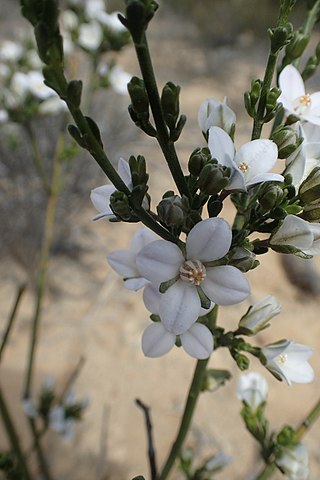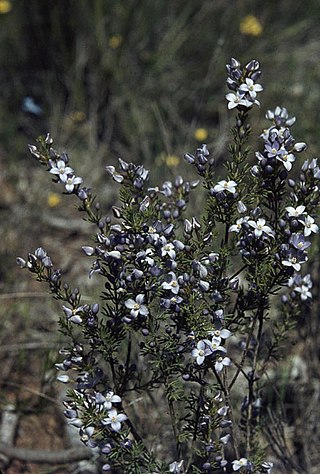
Cyanothamnus anemonifolius, commonly known as narrow-leaved boronia or sticky boronia, is a flowering plant that is endemic to south-eastern Australia. It is a shrub with mostly pinnate leaves, with white to pale pink four-petalled flowers in leaf axils.

Zieria odorifera, commonly known as the fragrant zieria, is a plant in the citrus family Rutaceae and is endemic to inland New South Wales. It is an aromatic shrub with ridged branches, leaves composed of three leaflets and groups of mostly three pale to deep pink, four-petalled flowers in spring.

Cyanothamnus nanus, commonly known as the dwarf boronia or small boronia is a plant in the citrus family Rutaceae and is endemic to eastern Australia. It is a prostrate or low spreading shrub with simple or three-part leaves and white or pale pink four-petalled flowers.

Boronia amabilis, commonly known as Wyberba boronia, is a plant in the citrus family, Rutaceae and is endemic to a small area in southern Queensland. It is an erect shrub with many branches, pinnate leaves with hairy lower surfaces and pink, four-petalled flowers.

Cyanothamnus quadrangulus, commonly known as narrow-leaved boronia, is a plant in the citrus family, Rutaceae and is endemic to eastern Australia. It is an erect shrub with four-angled branches, bipinnate leaves and white, sometimes pale pink, four-petalled flowers.

Cyanothamnus baeckeaceus is a plant in the citrus family, Rutaceae and is endemic to eastern Australia. It is a slender or straggling shrub with simple or trifoliate leaves and pink and white four-petalled flowers. It is endemic to the south-west of Western Australia.

Boronia barkeriana, commonly known as Barker's boronia, is a plant in the citrus family, Rutaceae and is endemic to eastern Australia. It is a shrub with ground-hugging branches, simple, toothed leaves and bright pink, four-petalled flowers.

Cyanothamnus coerulescens, commonly known as blue boronia, is a plant in the citrus family, Rutaceae and is endemic to southern Australia. It is a small, spindly shrub with glandular stems, small, more or less cylindrical leaves and blue to pinkish mauve, four-petalled flowers. There are two subspecies endemic to Western Australia and a third that also occurs in three eastern states.

Boronia granitica, commonly known as granite boronia, is a plant in the citrus family, Rutaceae and is endemic to a small area of eastern Australia. It is an erect shrub with many branches, compound leaves and pink, four-petalled flowers.

Boronia pilosa, commonly known as the hairy boronia, is a plant in the citrus family Rutaceae and is endemic to south-eastern Australia. It is an erect, woody shrub with hairy branches, pinnate, sometimes hairy leaves and groups of up to ten white to pink, four petalled flowers.

Cyanothamnus rigenss, commonly known as the stiff boronia, is a plant in the citrus family Rutaceae and is endemic to south-eastern New South Wales in Australia. It is a low, compact shrub with mostly trifoliate, glandular leaves and white to pale pink, four-petalled flowers in the leaf axils.

Cyanothamnus fabianoides is a plant in the citrus family, Rutaceae and is endemic to the south-west of Western Australia. It is a compact shrub with many branches, simple, more or less cylindrical leaves and single white, pink or pale blue four-petalled flowers in the leaf axils.

Boronia filicifolia is a plant in the citrus family, Rutaceae and is endemic to the far north-west of Australia. It is an erect or sprawling shrub with many branches, pinnate leaves with up to 55 leaflets and white to pink flowers with the sepals a similar length to the petals.
Cyanothamnus montimulliganensis is a plant in the citrus family Rutaceae and is endemic to a single mountain in Queensland. It is an erect, woody shrub with pinnate or bipinnate leaves and white, four-petalled flowers usually arranged singly in leaf axils.

Cyanothamnus polygalifolius, commonly known as dwarf boronia, milkwort-leaved boronia or milkwort boronia, is a plant in the citrus family Rutaceae and is endemic to eastern Australia. It is a low-lying shrub with simple leaves and white or pink flowers arranged singly or in groups of up to three in leaf axils.

Cyanothamnus ramosus is a species of plant in the citrus family Rutaceae and is endemic to the southwest of Western Australia. It is an erect, mostly glabrous shrub with pinnate leaves with up to seven leaflets, and white, four-petalled flowers with blue or pale green backs.

Boronia squamipetala is a species of plant in the citrus family, Rutaceae, and is endemic to Queensland, Australia. It is an erect shrub with pinnate leaves with between five and thirteen elliptic leaflets, and green to white, four-petalled flowers with hairy backs.

Boronia tolerans is a plant in the citrus family, Rutaceae and is endemic to a small area in the Northern Territory in Australia. It is an erect shrub with many branches, pinnate leaves and white, four-petalled flowers. It is only known from Nitmiluk National Park.

Cyanothamnus warangensis is a species of erect, woody shrub that is endemic to Queensland. It has bipinnate leaves and groups of between five and twenty-five or more white flowers in leaf axils.
Cyanothamnus yarrowmerensis is a species of erect, woody shrub that is endemic to Queensland. It has pinnate or bipinnate leaves and groups of up to seven flowers with white petals in leaf axils.




















